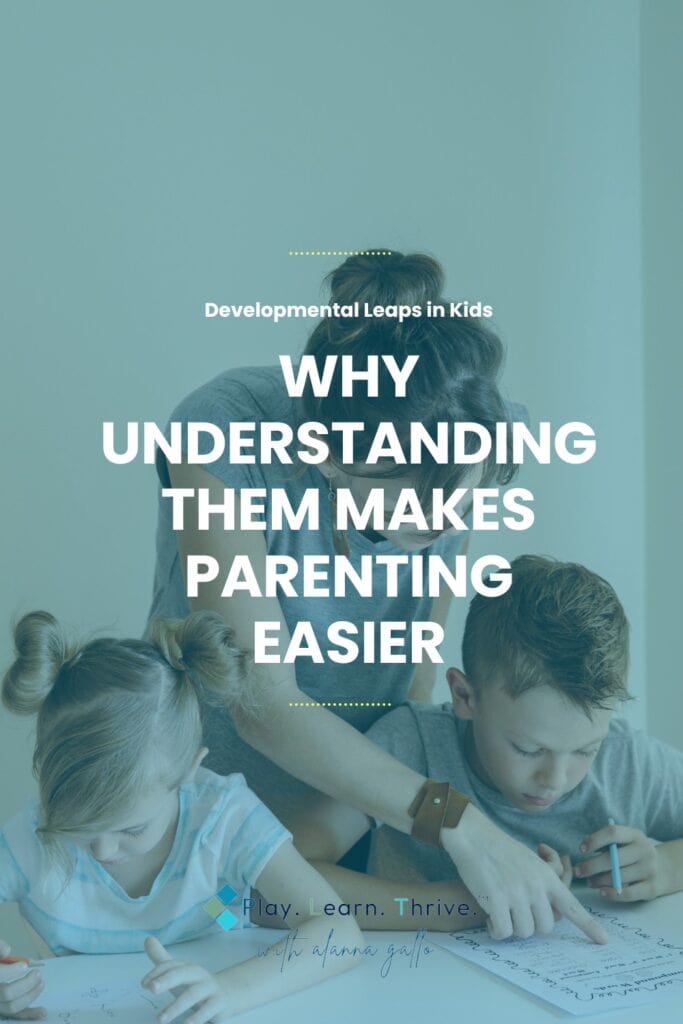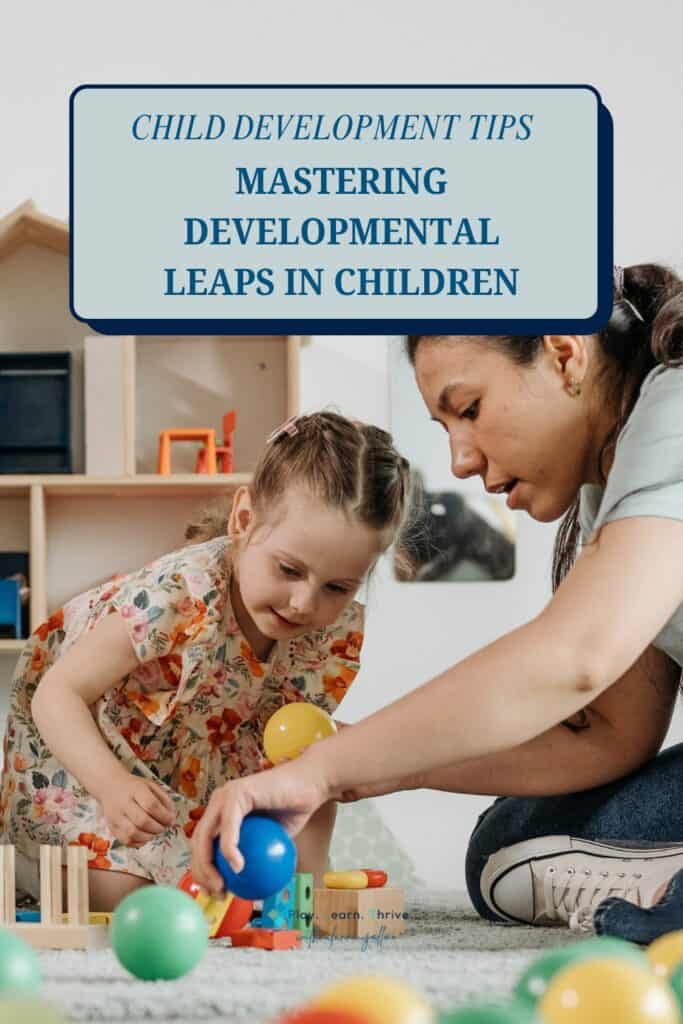Developmental Leaps in Kids: Why Understanding Them Makes Parenting Easier
Understanding developmental leaps can make parenting easier! Learn practical tips to support your child in each stage of development.

Play. Learn. Thrive.™ only endorses products we authentically love and use. Some of the product links in this post may be affiliate links. That means that if you click them and make a purchase, this site makes a commission. Play. Learn. Thrive.™ is also an Amazon Associate. As an Amazon Associate, we earn from qualifying purchases. It will have no impact on the price you pay or the experience of your purchase.
One day, your baby is all smiles and predictable routines. The next? It feels like they’ve hit a wall—suddenly clingy, fussy, or unable to sleep. Fast forward a few years, and your toddler or preschooler might be pushing boundaries in ways that leave you questioning everything.
Before you panic, know this: your child isn’t regressing—they’re progressing. These intense behavioral shifts are often due to developmental leaps, periods when the brain is rapidly advancing, making sense of new skills and information.
Understanding these leaps doesn’t just help you respond with more patience—it transforms your parenting experience. Instead of seeing these changes as random challenges, you’ll recognize them as signs of incredible growth.

What Are Developmental Leaps?
Developmental leaps are predictable stages of rapid brain development where children gain new cognitive, emotional, and physical skills. While growth isn’t always linear, researchers have identified clear patterns in how children’s brains evolve.
Think of a developmental leap like a software update on your phone. While the update is downloading and installing, things might glitch, freeze, or slow down. But once complete, you have access to new features and improved functionality.
The same happens with children. They experience a brief period of discomfort, frustration, or regression before emerging with newfound abilities.
Signs Your Child Is in a Developmental Leap
During a leap, children may display behaviors that seem out of character, including:
- Increased clinginess (even if they were previously independent)
- Disrupted sleep patterns
- Irritability or meltdowns over small things
- Fear of separation or new anxieties
- Sudden regression in skills (e.g., potty training, independent play, self-feeding)
- More intense emotions and reactions
These behaviors aren’t signs of misbehavior or manipulation—they’re signs of an evolving brain.
Ready to Take a Leap in Your Child's Development? Ditch the Screens!

50 Simple Screen-Free Learning Activities for Curious Kids
These 50 hands-on activities help children develop problem-solving skills, creativity, and real-world knowledge—without needing a screen. Designed to encourage self-directed play, hands-on discovery, and deep learning, this guide gives you a simple way to turn everyday moments into powerful learning opportunities.
Common Developmental Leaps and What They Mean
Infancy (0-2 Years): The Foundation of Growth
- Leap 1 (Around 5 Weeks): Sensory Awareness
- Your baby suddenly seems more alert, noticing lights, sounds, and faces in new ways.
- May become fussier due to overstimulation.
- Leap 4 (Around 4 Months): The World of Cause and Effect
- Suddenly, dropping a toy and watching you pick it up is endlessly fascinating.
- More frustration as they try (and fail) to grasp objects or roll over.
- Leap 6 (Around 8-9 Months): Object Permanence
- This is why separation anxiety spikes—your baby now understands you exist when out of sight.
- May cry more when left alone or resist naps.
Toddlerhood (1-3 Years): The Power Struggle Phase
- Leap 10 (Around 18 Months): Identity & Independence
- Cue the classic “NO!” phase—your toddler is testing autonomy.
- They crave control over their choices (even if that means tantrums over which socks to wear).
- Leap 12 (Around 2.5 Years): Emotional Awareness
- More intense tantrums? Check. Sudden bursts of empathy? Also check.
- Toddlers are learning to name emotions but don’t yet have impulse control, making this a tough stage for both kids and parents.
Preschool & Early Childhood (3-6 Years): The “Why” Era
- Leap 14 (Around 3-4 Years): Logical Thinking & Boundaries
- Your child is testing limits—not to push buttons, but to understand cause and effect.
- More negotiation, curiosity, and, yes, those endless “Why?” questions.
- Leap 15 (Around 5-6 Years): Social & Emotional Expansion
- Friendships become more important.
- They begin recognizing fairness, justice, and emotions in deeper ways.
Understanding these leaps helps shift your mindset from “Why is my child acting like this?” to “Wow, my child is leveling up!”

How Understanding Developmental Leaps Makes Parenting Easier
1. You React with Empathy, Not Frustration
Instead of assuming your child is being “difficult,” you realize they’re experiencing big internal changes. This allows you to respond with patience and support rather than punishment.
2. You Anticipate Changes Instead of Feeling Blindsided
When you know that a developmental leap is coming, you won’t be caught off guard when bedtime becomes a battle or separation anxiety spikes.
3. You Adapt Your Parenting Approach
Knowing what skills your child is developing allows you to adjust expectations and offer the right support. For example:
- If your toddler is going through a language explosion, give them more chances to express themselves before assuming they’re being defiant.
- If your preschooler is struggling with emotional regulation, model deep breathing instead of demanding they “calm down.”
4. You Find More Joy in the Process
Instead of focusing on the challenges, you begin celebrating the growth behind them. Those tough days suddenly feel worth it when you realize your child is learning something incredible.

Practical Tips for Navigating Developmental Leaps
- Increase Connection: Your child may need extra reassurance during leaps. Extra cuddles, eye contact, and playtime help them feel secure.
- Maintain Routines: Predictability reduces stress during chaotic growth periods.
- Validate Their Feelings: Say, “I see you’re frustrated because you can’t do that yet. It’s hard, but you’re learning!”
- Support, Don’t Solve: If your child is struggling with a skill, offer guidance but allow them to try—this builds resilience. This helps develop perseverance and a growth mindset.
- Lower Expectations (For Yourself, Too!): If a developmental leap has disrupted sleep or behavior, remember—it’s temporary. Give yourself grace and focus on survival mode when needed.
Growth Is Messy (But Worth It!)
Parenting through developmental leaps can be challenging, but when you understand what’s happening beneath the surface, everything shifts.
Your child isn’t testing your patience for fun. They’re learning how to exist in a constantly expanding world, and that takes time, practice, and—yes—some tough days.
Next time your child is extra clingy, extra whiny, or just seems off, remind yourself: they’re upgrading. And your job isn’t to fix it—it’s to guide them through it.
Inspired by this post? Be sure to subscribe download my free Screen-Free Starter Kit! For more insights and resources on raising confident, lifelong learners, be sure to follow me on Instagram – can't wait for you to join me!







